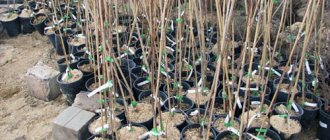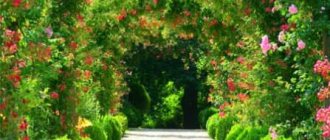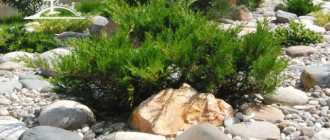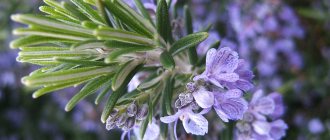Juniper in the design of the stairs
Junipers, with their thick short needles of rich colors, delightful texture and whimsical forms, are incredibly popular ornamental plants. In addition to their stunning appearance, species and selection diversity, the undoubted advantages of these conifers are their undemandingness to soil, resistance to cold and drought, and the ability to tolerate pruning well.
When is it better to plant juniper in spring or autumn?
Opinions differ as to when it is better to plant juniper in open ground, in spring or autumn. Some believe that it is preferable to do this in early spring. However, this is not the only possible option. You can purchase cuttings with a closed root system (hereinafter referred to as ZKS). They are suitable for planting on the site at almost any time of the year, including in winter during the thaw period.
Many experienced gardeners believe that planting Cossack, Horizontal, Rocky, Creeping and other types of juniper in the fall will be more successful. The seedling will take root better and withstand the upcoming frosts.
Read more about varieties of rock juniper in the article Rock juniper: planting and care
Many novice gardeners wonder whether it is possible to plant a plant in the fall in the Urals and Siberia. Of course, in the northern regions such a planting is extremely risky. However, if it was not possible to complete it in the spring, it can be done in early autumn. The tree will have time to take root if this is not done too late, but it will not begin to grow, which is extremely undesirable for wintering.
How to care outdoors
Care consists of periodic watering, fertilizing, and sanitary pruning. Particular attention is paid to juniper in early spring and autumn.
The soil
Juniper will show the greatest decorative value when growing on sandy loam, fertilized soils. If the soil is dense, the plants will develop slowly. The soil should not be swampy. Conifers tolerate slight drought more easily than waterlogging. When water stagnates, the root system is affected by pathogenic microorganisms.
Temperature and humidity
Almost all varieties of juniper tolerate temperature changes well. They can withstand short-term droughts and severe winter frosts. At high temperatures, green needles may turn light brown. In summer, the bushes are given sprinkling. Water will wash away the dust, and it will be easier for plants to develop.
Watering
Water the seedling abundantly when planting. Having been saturated with water, the juniper root system will quickly take root in a new place. once a week throughout the entire season . In subsequent years, watering is required only during prolonged drought. For adult plants, rainfall in the spring-autumn period is sufficient.
Trimming
sanitary pruning is carried out . Dry, diseased, and asymmetrically developing branches are cut out. Trim the shoots so that no stumps remain. Juniper can also be pruned to create a beautiful configuration. But most often it is left to grow in its natural form.
Top dressing
Conifers do not require frequent fertilization. For active growth of shoots in the spring, you can add nitroammophos at the rate of 40 g per m² . Nitrogen fertilizer cannot be used in autumn. Young branches, not having time to get stronger, will freeze in winter. In summer, mineral fertilizer is applied once a month.
Flowering and fruiting
At the age of 5-8 years, juniper begins to bloom. In monoecious plants, only male bright yellow spikelets or only female green elongated buds are formed.
Juniper blossom
If the shrub is dioecious, flowers of different sexes are formed on the shoots. The buds open in late May or early June. After flowering, dark blue or red-brown berries are formed, covered with a waxy coating.
Juniper berries
How to care in spring
The greatest danger for juniper in spring is the sun's rays. They can burn the needles. To prevent this from happening, in early spring the crown is covered with burlap . At the same time, the ground under the bushes is watered abundantly. If there is a lack of moisture, the needles may dry out.
How to care for autumn
In mid-autumn, moisture-recharging irrigation . When cold weather sets in, the tree trunk circle is sprinkled with peat or sawdust. If heavy snowfalls are expected, the crown is tied together with twine. Otherwise, by spring it will take on a sloppy appearance. Young conifers are covered with spunbond.
When to plant juniper in the fall: optimal timing
When choosing landing dates, you should rely on the region and the recommendations of the Lunar calendar.
By region
Deadlines by region:
- central Russia, including the Moscow region - late September-early October;
- Siberia, Ural, North-Western regions - September;
- southern regions - October, if the weather is warm, then the beginning of November.
According to the Lunar calendar for 2022
| Month | Favorable days | Unfavorable, prohibited days |
| September | 1-5, 8, 9, 14-16, 19-20, 28-30 | 6, 7, 10, 11, 17,18, 21, 22 |
| October | 1-4, 8, 9, 16-19, 22, 26-31 | 5, 6, 7, 14, 15, 19, 20, 21 |
| November | 1-3, 6-9, 12-14, 22-24, 27-30 | 4, 5, 10, 11, 14-16, 18, 19-21 |
Read the articles:
- Florist's lunar calendar for 2022.
- Florist's lunar calendar for September 2022.
- Florist's lunar calendar for October 2022.
- Florist's lunar calendar for November 2022.
How to choose a high-quality juniper seedling and its preparation
It is very important to choose a good seedling, since the survival rate, adaptation and successful development of the plant in the coming season will directly depend on this. You need to purchase planting material only in specialized stores and gardening centers.
Seedlings of this coniferous tree are sold with a closed root system (ZRS). That is, it is placed in an earthen lump, which is located in a pot or other container. Such cuttings are also called container type. This planting material is easy to work with.
There are also seedlings with an open root system (OKS). That is, their roots are exposed. But this option is extremely rare. In addition, ACS will complicate the landing process.
Rules for choosing seedlings:
- Give preference to specimens that are 3-4 years old.
- They are free of any signs of damage, disease or pests.
- The needles have a healthy color (green or one that matches the variety). You cannot buy seedlings that are brown and dry. Also, it should not crumble. It’s easy to check the condition of the needles. To do this, you need to squeeze it in your palms for a few seconds and release. If the needles immediately return to their previous shape, it means the juniper is healthy.
When a seedling is purchased, it needs to be prepared for planting. Approximately one day before transplanting, water from the transport container with a root formation stimulator. For example, a solution of Kornevin or Heteroauxin.
Important! After removing the seedling from the pot, it must be immediately planted in a permanent place. The roots should not be exposed to air for more than a quarter of an hour, otherwise they will begin to dry out, which will have a negative impact on the health of the plant in the future.
Reproduction methods
The plant reproduces in the following ways:
- seeds;
- cuttings;
- seedlings.
Seeds are a difficult way to grow juniper; they are used only in breeding centers. It takes 4–5 years to obtain a seedling ready for planting in the ground. Traditionally, for growing in summer cottages, gardeners recommend buying ready-made seedlings from nurseries. This way you can be confident in the quality of the shrub and its selection characteristics.
Did you know? Juniper was first used for medicinal purposes in Ancient Egypt. Its decoctions were used to treat psoriasis, eczema, and lichen.
Cuttings are the second most popular method of plant propagation. For proper harvesting, they are cut in April or May, a shoot no longer than 12 cm is taken so that a piece of bark remains on the branch, then they are cleared of needles to this area with bark, and then planted in sand mixed with peat in a 1:1 ratio. A bucket or pot with cuttings is regularly sprayed with water and waiting for rooting. After 2 months, you can plant the plant in the ground. For the winter, young juniper is always covered with non-woven fabric or agrofibre.
Where to plant juniper in the garden: choosing a location
Juniper grows best in sunny areas. In this case, it will form a lush and beautiful shape. If you plant a bush in the shade, especially next to fruit trees, the plant will be more susceptible to infectious agents and pests.
In landscape design, when planting juniper, they play on the contrast of color and shape. This plant looks good next to thuja, biota, and dwarf pine. To create a spectacular composition, you can plant 3-5 different plants.
How to plant thuja in the fall, read the article Planting thuja in the fall: timing, rules, step-by-step instructions. And also about other dwarf conifers: Dwarf coniferous plants for your site: a beautiful garden in autumn and winter.
Near a private house, juniper harmonizes with rose bushes. They create a bright contrast against the background of emerald needles. If you plant the plant under the windows, it will emit a pleasant aroma and also repel flies and mosquitoes.
Juniper is not particularly picky about soil, but prefers slightly acidic soil.
How to prepare a planting hole for autumn planting
When digging holes for several plants, you need to maintain distance:
- between small specimens - 50 cm;
- between tall bushes - 1.5-2 m.
Step-by-step technology on how to properly dig a hole:
- Dig holes of such depth and width that they are 2 times the volume of the earthen clod.
- Lay out a drainage layer of 10-15 cm.
- Prepare soil from coarse sand, peat, turf in a proportional ratio of 1:2:1 (standard recipe). Juniper preferences for soil composition may vary depending on the species. For example, Virginsky prefers a clayey substrate (peat, sand, clay turf 2:1:2).
- Fill the hole halfway with prepared soil. Leave the remaining part; it will be needed when the juniper is planted.
Important! The pit needs to be prepared in advance, approximately 2-3 weeks before the expected planting day. Thanks to this, the earth will have time to settle naturally.
Mulching
For junipers 1–2 years old, many problems are caused by weeds, which draw useful substances from the ground and support pathogenic microflora. Therefore, the tree trunk circle needs to be regularly weeded and mulched. Best coverage options:
- pine bark;
- wood chips;
- walnut or pine nut shells;
- peat;
- cones and needles;
- agrofibre.
For effective protection against weeds, the mulch layer should be 5–7 cm. It is undesirable to use sawdust and hay, as they can introduce pests to the plant.
Planting juniper in the fall: a step-by-step guide
Description of how to plant juniper in the garden in open ground in the fall:
- Prepare all the necessary tools in advance. Bring the seedling as close to the hole as possible so that during planting its roots have as little contact with oxygen as possible.
- Carefully remove the bush from the container along with the earthen lump. To make this easier, place the pot on its side and gently tap the sides with a spatula. Pull the seedling out by the very bottom of the trunk.
- Immediately place the shoot in the hole without destroying the earthen ball.
- Fill with the remaining soil. The root collar of large specimens should be 5 cm above the ground, while for young and medium-sized specimens it should be at ground level. Compact the soil a little.
- Create a circle near the trunk so that walls of soil 10 cm high are formed around the trunk.
- Water the bush. When the moisture is absorbed, mulch the tree trunk circle with a layer of about 10 cm.
Planting juniper does not require any special requirements. Everything is done according to the standard scheme.
Caring for juniper after planting in autumn
The plant calmly tolerates the absence of water for a long time, but immediately after planting the bush must be watered at the root. This will help the cuttings adapt better and protect them from dehydration during difficult periods.
x-default
Water every month during the growing season for the first year. Then there will be enough precipitation.
Juniper branches need to be pruned extremely carefully, since any damage takes a long period of time to heal. When pruning, the crown can be given any shape. Also during the process you need to remove broken, dried and damaged branches.
Before wintering, tie the crown with twine. Thanks to this, the branches will not break under the weight of snow.
Problematic points
Inadequate tree care or the presence of unfavorable plants nearby creates the following problems:
- The needles dry out. In winter, you need to water the ground near the trunk with hot water and cover the tree.
- The appearance of rust (orange growths on branches). This indicates the appearance of a fungus. Affected branches are cut off and burned. The fungus appears when planted near fruit trees (apple, pear). Spraying with a fungicidal preparation will help.
- Fusarium infection. The appearance of a white coating near the root. This disease has no cure. The tree is dug up and burned.
Tips for a florist on caring for junipers from Mr. Summer Resident
Some useful tips:
- cut off branches damaged by frost or scorching sun to a healthy area, without sparing;
- Regular spraying of needles will make them more elastic and give them an attractive shade;
- If the soil is dry or has a high sand content, add a little clay.
Growing juniper on your own plot is not difficult, as it requires minimal care. It will be an excellent addition to landscape design, and its cut branches, placed at home, will be an excellent protection against pathogenic microorganisms, as they have bactericidal properties.
Botanical description
The horizontal juniper is known in botanical literature as Juniperus horizontalis hughes. Also in the description there is a mention of “prostrate”, which means “creeping”. It is distinguished by a variety of varieties, as well as a rich color palette. Of all the representatives of its species, it is the most unpretentious and tolerates the absence of sun well. It has earned popularity among gardeners due to its high frost resistance and excellent adaptive characteristics. You can plant such a plant even on the most infertile soils. Reviews often mention such qualities of horizontal juniper as its spectacular appearance, especially as part of garden landscape compositions.
Important! Yellow junipers can darken with a lack of sun; this is the biological norm for these plants.
Plant characteristics:
- maximum height of the bush - 50 cm;
- cultivation in partial shade or in regions with harsh climates is permissible;
- prefers both alkaline and acidic soils, and the degree of growth depends mainly on watering;
- the most common methods of propagation are cuttings and seeds, as well as ready-made seedlings;
- high resistance to frost and dust;
- high life expectancy (up to 200 years).











